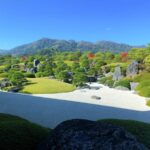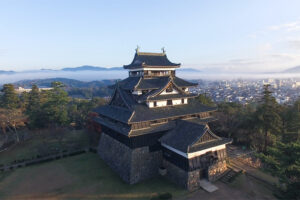
Matsue Castle, located in Matsue City, Shimane Prefecture, is one of only 12 original castles in Japan whose main keep (tenshu) has survived intact since the feudal period.
Built in 1611 by feudal lord Horio Yoshiharu, the castle is a masterpiece of early Edo-period military architecture and is often called the “Black Castle” because of its striking dark wooden exterior.
Set atop a small hill overlooking Lake Shinji and Lake Nakaumi, Matsue Castle offers panoramic views, rich samurai history, and the tranquil beauty of one of Japan’s best-preserved castle towns.
In 2015, it was officially designated a National Treasure, making it one of the most important cultural and historical landmarks in Japan.
Contents
Key Facts
-
Location: Matsue City, Shimane Prefecture, Japan
-
Built: 1607–1611
-
Founder: Horio Yoshiharu (feudal lord of the Matsue Domain)
-
Structure Type: Hilltop castle (hirayamajiro)
-
Height of Main Keep: Approx. 30 meters (98 ft)
-
National Treasure Designation: 2015
-
Nickname: “Chidori Castle” (Castle of Plovers)
History
The Birth of Matsue Castle
After the Battle of Sekigahara (1600), Horio Yoshiharu was granted control over the Izumo region. He chose Matsue as his new castle site because of its strategic location between two large lakes, allowing control of both transport and defense.
Construction began in 1607 and took five years, completed in 1611. Unlike many other castles that were later destroyed in wars or by government order, Matsue Castle survived the Meiji Restoration due to strong local preservation efforts.
Clan Succession
After Horio’s death, the castle was controlled by the Kyōgoku Clan and later by the Matsudaira Clan, a branch of the Tokugawa shogunate family.
Under the Matsudaira, Matsue flourished as a samurai city of culture and learning, known as the “City of Water.”
Architecture
Exterior Design
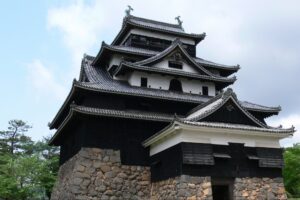
-
Constructed primarily of dark wooden planks and black tiles, giving it a powerful yet elegant appearance.
-
The design is defensive rather than decorative, featuring thick stone walls, narrow windows for archers, and steep stairs to slow intruders.
-
The curved gables resemble the wings of a bird — hence its nickname “Chidori Castle” (Castle of Plovers).
Structure
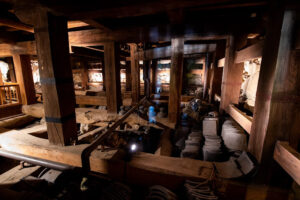
-
Five stories (visible) but six internal floors, including a hidden basement for storing weapons and supplies.
-
Built using a combination of massive wooden beams, interlocking joints, and stone foundations — all without nails.
-
Observation platform at the top offers 360° views of Matsue City, Lake Shinji, and the surrounding mountains.
Defensive Features
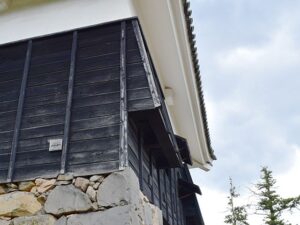
-
Hidden doors and staircases for surprise counterattacks.
-
Murder holes (ishi-otoshi) for dropping stones on enemies.
-
Thick plastered walls for fire resistance.
Despite its strength, Matsue Castle was never attacked in battle, so its original structure remains beautifully preserved.
Inside the Castle
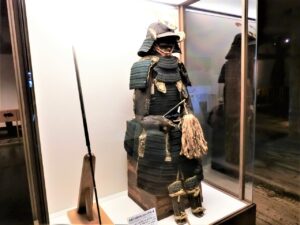
Today, the castle serves as a museum, displaying:
-
Samurai armor and weapons from the Edo period.
-
Old maps, artifacts, and documents from the Horio and Matsudaira clans.
-
Scale models showing the original layout of Matsue’s castle town.
-
Reconstructed rooms showing how samurai officers once lived.
Visitors can climb to the top observation floor, where you can enjoy a panoramic view of Lake Shinji, Lake Nakaumi, and the city of Matsue — a stunning sight at sunset.
The Castle Grounds
Surrounding Matsue Castle is a large park area known as Matsue Jōzan Park, which retains its Edo-period layout.
Seasonal Highlights
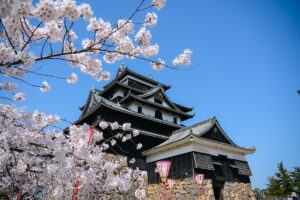
-
Spring (late March–April): Over 400 cherry trees bloom around the moat, making it one of Japan’s top sakura-viewing spots.
-
Summer: Lush greenery and hydrangeas line the moat.
-
Autumn: Brilliant fall foliage enhances the castle’s black facade.
-
Winter: Light snow creates a magical, serene atmosphere.
Moat Cruise
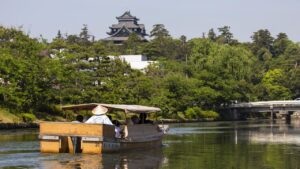
You can enjoy the Horikawa Sightseeing Boat, a low-roofed wooden boat that circles the castle moat and historic town canals.
-
Duration: ~50 minutes
-
Features: Low bridges where passengers must bow their heads — a fun and memorable experience.
-
Commentary available in English.
Nearby Attractions
Matsue Castle is the center of a beautifully preserved castle town filled with cultural landmarks:
Samurai Residence (Buke Yashiki)
A restored samurai house from the Edo period where visitors can learn about samurai life and traditional interiors.
Shiomi Nawate Street
A charming street lined with white-walled traditional buildings, teahouses, and museums, offering a glimpse of old Japan.
Lafcadio Hearn’s Former Residence & Memorial Museum
The Greek-Irish writer Lafcadio Hearn (Koizumi Yakumo), who loved Japanese folklore, lived in Matsue in the 1890s. His former residence and museum are within walking distance of the castle.
Lake Shinji (宍道湖)
Just a short walk away — famous for Japan’s top 100 sunsets. Visitors can watch the glowing sun sink behind the lake from the Shinjiko Ohashi Bridge or Sunset Spot Park.
Access
Address:
1-5 Tonomachi, Matsue City, Shimane Prefecture 690-0887, Japan
By Train:
-
From Matsue Station (JR San’in Line), take the Lakeline Loop Bus to “Matsue Castle (Otemae)” stop — about 10 minutes.
-
Or a 20-minute walk from Matsue Station.
By Car:
-
Free and paid parking available around Matsue Castle Park.
From Major Cities:
-
From Tokyo: Fly to Izumo Enmusubi Airport (1 hr 20 min) → Bus to Matsue (~45 min).
-
From Osaka: JR train (via Okayama) or overnight bus (~4.5 hrs).
Admission & Hours
| Category | Admission Fee |
|---|---|
| Adults | ¥680 |
| Children (Elementary–High School) | ¥290 |
-
Hours: 8:30 AM – 6:30 PM (April–September) / 8:30 AM – 5:00 PM (October–March)
-
Closed: Open year-round (may close temporarily for maintenance)
Combo tickets are available for Horikawa Boat + Castle + Buke Yashiki.
Why Visit Matsue Castle?
-
One of only 12 original castles remaining in Japan
-
Offers spectacular views of lakes, city, and mountains
-
A living time capsule of the Edo samurai era
-
Surrounded by moats, cherry trees, and canal boats
-
A four-season destination blending nature and history
-
Designated a National Treasure and symbol of Matsue
Travel Tips
Visit in early morning or sunset for the best light and fewer crowds.
Take the Horikawa Boat Cruise before exploring the castle — it gives great context to the castle town’s layout.
Wear comfortable shoes — interior stairs are steep and narrow.
Visit the Lafcadio Hearn Museum nearby to understand Matsue’s literary and spiritual heritage.
Don’t miss nighttime illumination events in spring and autumn.
Summary
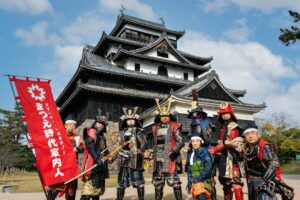
Matsue Castle is not just an architectural masterpiece — it’s a window into Japan’s samurai past, standing gracefully above a city still shaped by water, culture, and tradition.
Its black-timbered tower, surrounded by cherry blossoms, moats, and canals, captures the spirit of old Japan — elegant, strong, and serene.
Whether you’re a lover of history, architecture, or quiet beauty, Matsue Castle offers an unforgettable journey into Japan’s living heritage.
Related articles
Official Website
https://www.visit-matsue.com/
Accommodation sites
Agoda
